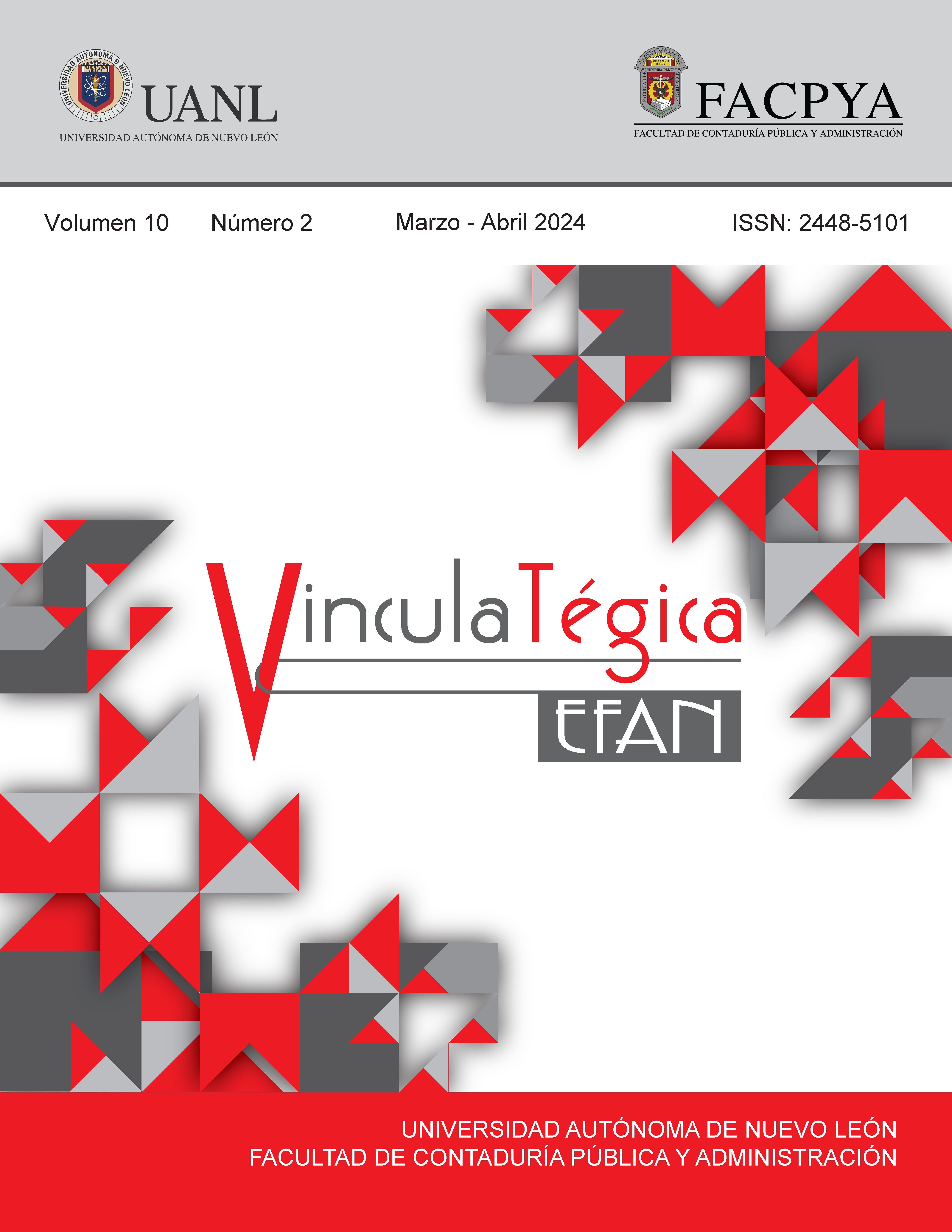Theoretical and methodological proposal for social entrepreneurship and community productivity in the lake region of Patzcuaro, Michoacan.
DOI:
https://doi.org/10.29105/vtga10.2-481Keywords:
Empowerment, Social entrepreneurship, social innovation, business model, Community productivityAbstract
The purpose of this research is to design a methodological theoretical proposal for the study of the variables social entrepreneurship and community productivity in the Lake Region of Patzcuaro, Michoacan, Mexico, which allows determining the degree of social incidence based on the correlation between the two variables mentioned. The study was descriptive, resulting in the design of the theoretical and methodological model of the variables under study and the conceptualization of the corresponding dimensions. It is concluded that, for the purposes of this research, social entrepreneurship (independent variable) is a transformative process involving the empowering elements: social actors, socioeconomic aspects, business model and social innovation. Regarding community productivity (dependent variable) it is conceptualized as those economic activities that emanate from the social practices of a community in order to guarantee the satisfaction of its basic needs and improve its quality of life, the dimensions are: popular economy, available resources, social articulation and community empowerment. With the aforementioned, the theoretical and methodological bases are established for subsequent statistical and practical applications.
Downloads
References
Barki, E., Comini, G., Cunliffe, A., Hart, S. y Shu, S. (2015). Social entrepreneurship and social business: retrospective and prospective research. RAE-Revista de Administração de Empresas/FGV-EAESP. São Paulo. 55(4), pp. 380-384. http://dx.doi.org/10.1590/S0034-759020150402. DOI: https://doi.org/10.1590/S0034-759020150402
Bustillos Bailey, Antonio, Sánchez Nogales, Cecilia, López Murillo, Sara, & Campana Arroyo, Guerel. (2020). Entre el emprendedurismo y la subsistencia. Revista Investigación y Negocios, 13(21), 112-121. https://doi.org/10.38147/inv&neg.v13i21.87 DOI: https://doi.org/10.38147/invneg.v13i21.87
Caicedo, S., Solarte-Pazos, L., (2015). Empoderamiento de mujeres de una ONG colombiana. Un estudio de caso simple. Rev. Adm. Pública-Rio de Janeiro, 49(6), pp. 1596-1618. https://doi.org/10.1590/0034-7612135980 DOI: https://doi.org/10.1590/0034-7612135980
Castelao, M. E. y Srnec, C. C. (2013): Public Policies Addressed to the Social and Solidarity Economy in South America. Toward a New Model? VOLUN- TAS: International Journal of Voluntary and Nonprofit Organizations, 20(3): 713-732. http://dx.doi.org/10.1007/s11266-012-9276-y DOI: https://doi.org/10.1007/s11266-012-9276-y
Chesbrough, H. (2010). Business Model Innovation: Opportunities and Barriers, Long Range Planning, 43(2), 354-363. https://doi.org/10.1016/j.lrp.2009.07.010 DOI: https://doi.org/10.1016/j.lrp.2009.07.010
Christensen, C. M., T. Bartman y D. Van Bever. (2016). The Hard Truth about Business Model Innovation, MIT Sloan Management Review, 58(1), 31-40
Cieza, J. A. (2006) Educación comunitaria. Revista de Educación. (339), pp. 765-799.
COESPO. (2020). Características Económicas Michoacán, Consejo Estatal de Población, https://coespo.michoacan.gob.mx/wp-content/uploads/2021/03/Caracteriticas-Economicas-Michoacan-2020.pdf
Coy, D., Malekpour, S., Saeri, A. K. & Dargaville, R. (2021). Rethinking community empowerment in the energy transformation: A critical review of the definitions, drivers and outcomes. Energy Research & Social Science, 72, Article 101871. https://doi.org/10.1016/j.erss.2020.101871 DOI: https://doi.org/10.1016/j.erss.2020.101871
González Fernández-Larrea, M., González González, G. R., González Aportela, O., & Batista Mainegra, A. (2021). Educación y sociedad: universidad, extensión universitaria y comunidad. Revista Cubana de Educación Superior, 40(Supl. 1), 20. http://scielo.sld.cu/scielo.php?script=sci_arttext&pid=S0257-43142021000400020&lng=es&tlng=es.
Gupta, P., Chauhan, S., Paul, J., & Jaiswal, M. P. (2020). Social entrepreneurship research: A review and future research agenda. Journal of Business Research, 113(C), 209–229. https://doi.org/10.1016/j.jbusres.2020.03.032 DOI: https://doi.org/10.1016/j.jbusres.2020.03.032
Hernández, P. J. (2007). Educación y desarrollo comunitario:Dialogando con Marco Marchioni. Cuestiones Pedagógicas. (18), pp. 285-300.
Hossain, F. and Ali, M. (2014) Relation between Individual and Society. Open Journal of Social Sciences, 2, 130-137. http://dx.doi.org/10.4236/jss.2014.28019 DOI: https://doi.org/10.4236/jss.2014.28019
Kraus, S., Niemand, T., Halberstadt, J., Shaw, E., & Syrja, P. (2017) Social entrepreneurship orientation: development of a measurement scale. International Journal of Entrepreneurial Behavior & Research., 23(6), pp. 977–997. https://doi.org/https://doi.org/10.1108/IJEBR-07-2016-0206. DOI: https://doi.org/10.1108/IJEBR-07-2016-0206
Malunga, P., Gervase, C. y Virimai, V. (2014) “Social Entrepreneurs and Community Development, A Literature Analysis”, Mediterranean Journal of Social Sciences, 5(16). MCSER Publishing, Rome-Italy. pp.18-26. http://dx.doi.org/10.5901/mjss.2014.v5n16p18. DOI: https://doi.org/10.5901/mjss.2014.v5n16p18
Martínez Moncaleano, C. J., & Palencia Fajardo, O. (2021). Modelo de minería de datos para el análisis de la productividad y crecimiento personal en las mujeres emprendedoras: el caso de la Asociación las Rosas. Suma de Negocios, 12(26), 23-30. https://doi.org/10.14349/sumneg/2021.v12.n26.a3 DOI: https://doi.org/10.14349/sumneg/2021.V12.N26.A3
Martínez Moreno, R., & Sotelo Ahumada, H. (2021). Análisis de la valoración hedónica de la vivienda del Área Metropolitana de Monterrey (2021). Vinculatégica EFAN, 7(2), 744–752. https://doi.org/10.29105/vtga7.1-139 DOI: https://doi.org/10.29105/vtga7.1-139
Pérez-Wilson, P., Marcos-Marcos, J., Morgan, A., Eriksson, M., Lindström, B., & Álvarez-Dardet, C. (2021). "A synergy model of health’: an integration of salutogenesis and the health assets model”. Health Promotion International, 36(3), 884-894. https://doi.org/10.1093/heapro/daaa084 DOI: https://doi.org/10.1093/heapro/daaa084
Rappaport, J. (1981) In praise of paradox: a social policy of empowerment over prevention. American Journal of Community Psychology, (1)9, pp. 1-25. https://doi.org/10.1007/BF00896357 DOI: https://doi.org/10.1007/BF00896357
Sarria, A., & Tiribia, L. (2004). Economía popular. La otra economía. Buenos Aires: Altamira, 137-186.
Tapia Salazar, M., Adame Rodríguez, L., & Villanueva Pimentel, M. (2021). Estrategia de nodo de impulso a la economía social y solidaria para MiPyMES ante pandemia: artesanos de la región Pátzcuaro. Vinculatégica EFAN, 7(1), 566–575. https://doi.org/10.29105/vtga7.2-38 DOI: https://doi.org/10.29105/vtga7.2-38
Vaandrager L, Kennedy L. (2017) The application of salutogenesis in communities and neighborhoods. In: Mittelmark MB, Sagy S, Eriksson M, Bauer GF, Pelikan JM, Lindström B, et al., editors. The handbook of salutogenesis. Switzerland: Springer Nature; 2017. p. 159-70. DOI: https://doi.org/10.1007/978-3-319-04600-6_17
Wilkinson, K.P. (2023). The community in rural America. University Press of Colorado. Denver, Colorado.
Zimmerman, M. A. (2000). Empowerment theory: Psychological, organizational and community levels of analysis. En J. Rappaport & E. Seidman (Eds.), Handbook of community psychology (pp. 43-63). Springer. https://doi.org/10.1007/978-1-4615-4193-6_2 DOI: https://doi.org/10.1007/978-1-4615-4193-6_2
Downloads
Published
How to Cite
Issue
Section
License
Copyright (c) 2023 Laura Adame Rodríguez, Maricela Villanueva Pimentel, Alma Alvarado López

This work is licensed under a Creative Commons Attribution 4.0 International License.
a). Authors keep copyright and give the journal the right of the first publication of the work under a Creative Commons attribution license. This license allows others to share the work as long as original authorship and initial publication in this journal is acknowledged.
b). Authors may make other independent and additional contractual agreements for the non-exclusive distribution of the version of the article published in this journal (e.g., include it in an institutional repository or publish it in a book) as long as they clearly indicate that the work was published for the first time in this journal.







